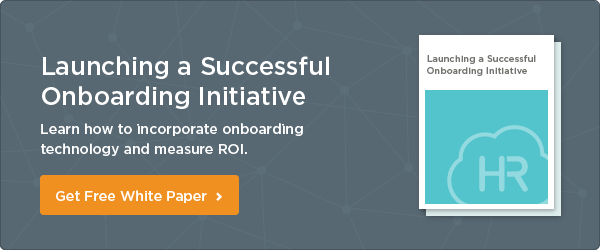
 Try
Out
Our
Try
Out
OurEmployee Engagement Software For Free

So often we find ourselves trying to perfect the recruiting process—trying to attract the right talent at the right time for the right job. We spend vast amounts of effort, money, and resources getting candidates in the door and converting them to new hires so much so that we forget about them once they start. If done incorrectly, onboarding can be a bad experience…like throwing cold water on that warm, fuzzy feeling you worked hard to create.
Keep your new employees happy, motivated and ready to contribute from before “day one” by enhancing your onboarding process. If you have an onboarding process now or are considering implementing one, here are 5 things to avoid:
Tweet: If you have an onboarding process now or are implementing one, here are 5 things to avoid.
1. Paperwork
Sure, forms are a necessary evil and are required to get the ball rolling. I’m not suggesting you dump forms or skip legal requirements; however, incorporate your paper forms into an electronic format that provides ease of completion before new hires enter the building. Forms can be downloaded, filled out, scanned or even signed electronically and then stored in the cloud without much effort at all. I know you know this; however, many companies that exist to serve their customers with the latest in technology gadgets and products are often side-stepping onboarding technology and limiting their chances of creating a great first impression with new hires.
2. A Broken Buddy System
Buddies are great for that first day…first week…first few months. New hires feel more comfortable linking up with a more senior colleague that is knowledgeable about firm nuances, organizational structure, dress code, completing time sheets and expense reports just to name a few. But pairing your new hire with the wrong buddy? That’s a mistake. Here’s why: not everyone is cut out to be a buddy. And whether you like it or not, your assigned buddy is an extension of your brand and must be the best ambassador to help carry your brand and the new hire to the finish line, meaning those difficult and often ignored first 90 days on the job. So, take time to pair correctly. This is not the time to forcefully ask someone to be a buddy. Those typically fail. Instead, make your buddy program shine—something that employees strive to be a part of. It should be fun, interesting, and a way to “give back” to others. It can also be performance driven and incorporated into annual appraisals with “extra points” for mentoring others and being a great buddy. After all, you need this program to hit the sweet spot for everyone, so drive it home with accountability, rewards for participation, and demonstrate how the program builds and extends your brand.
3. Slow Training
You brought on your new hire because they have the skill set to do the job. You probably paid an above-market salary (because competition is tight!) and a $5K signing bonus. So, why are you letting them sit there for a week or two with nothing to do? True, you need to train them to your standards (especially in a medical setting); however, if you haven’t assigned a trainer or provided some other method for getting your new hire up and running, you’re burning money—think salary, potential revenue, and time wasted.
4. The Sloppy Hand-off
If you find yourself in a recruiting role where all you do is recruit and then you pass the baton to the onboarding team, you might find that your new hire feels a bit lost. They’ve spent so much time with you during the interviewing and offer stages. You’re their connection to the organization; they expect to see you at orientation; they expect that your smiling face will put them at ease. This is the relationship that continues beyond the recruiting phase and well in to the onboarding and engagement phase. If you find you are detached from this process because it’s just done differently in your organization, be sure to explain to your new hire what’s going to happen next. There is a hand-off but you will still be around to answer questions. You’ll have an open door and would love to hear how the first week is going. Make sure you stay connected and they feel a sense of belonging. It’s not a great feeling to find that you are “hooked and then dropped” during the onboarding experience.
5. Not Following Up On Feedback
Asking new hires what they think about your onboarding process is great! But not listening and following through with action is bad. This is your chance to improve on what doesn’t work, what should work better, and fill in the gaps with anything that’s missing. This experience is critical to long-term engagement and is an extension of your brand. Don’t miss out on this huge opportunity to build relationships and create the link to your company culture.
Keep Reading
Benefits of Having a Company Intranet
Company intranets have been a part of corporate life since the mid-'90s. But in the last
Top 8 Workvivo Alternatives for 2024
Meta recently announced that it is shutting down its employee communications tool







